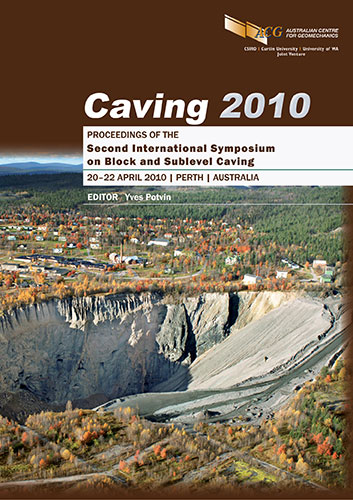Influence of major fault zones on 3D ground deformations caused by open pit block cave interactions

|
Authors: Severin, J; Eberhardt, E; Woo, KO |
DOI https://doi.org/10.36487/ACG_rep/1002_31_Severin
Cite As:
Severin, J, Eberhardt, E & Woo, KO 2010, 'Influence of major fault zones on 3D ground deformations caused by open pit block cave interactions', in Y Potvin (ed.), Caving 2010: Proceedings of the Second International Symposium on Block and Sublevel Caving, Australian Centre for Geomechanics, Perth, pp. 455-468, https://doi.org/10.36487/ACG_rep/1002_31_Severin
Abstract:
Surface mining operations are increasingly transitioning to underground mass mining operations like block caving to extend the life of the mine. The presence of the open pit above the developing block cave will lead to complex stress–strain interactions, pit slope movements and ground deformations that may extend beyond the periphery of the pit, potentially having an adverse effect on mine infrastructure and operations within the zone of disturbance. These can be further complicated by major fault zones that crosscut the mine property. Experiences at the Palabora Copper Mine in South Africa provide one such example of a transition to block cave mining where the interactions that developed between the underground workings and overlying steep rock slopes evolved into a massive 800 m high pit slope failure. To properly assess the rock mass response to these interactions for the management of pit slope stability, surface subsidence and setback distances for mine infrastructure outside the pit rim, as well as for planning future underground development, understanding the controlling influence of geological structures on the ground response is crucial. Results are presented here from a series of 3D continuum and discontinuum numerical models that investigate the interactions between the open pit, block cave mine and large scale geological features present at Palabora. These results are compared to a detailed review of pit slope monitoring data to help provide understanding of the complex slope displacement patterns recorded and apparent pit slope kinematics.
References:
Arndt, S., Beck, D., Reusch, F., Thin, I., Stone, C., Heap, M. and Tyler, D. (2007) Deep and high stress mining – Deformation and seismicity, 2007 ABAQUS Users Conference, www.beckarndt.com.au.
Beck, D., Reusch, F., Arndt, S., Thin, I., Stone, C., Heap, M. and Tyler, D. (2006) Numerical modelling of seismogenic development during cave initiation, propagation and breakthrough, in Proceedings Deep and High Stress Mining 2006, Hassani (ed), Balkema, Rotterdam, pp. 405–414.
Board, M., Seldon, S., Brummer, R. and Pakalnis, R. (2000) Analysis of the failure of a large hangingwall wedge: Kidd Mine Division, Falconbridge, Ltd, CIM Bulletin, Vol. 93(1043), pp. 89–97.
Brummer, R., Li, H. and Moss, A. (2006) The transition from open pit to underground mining: An unusual slope failure mechanism at Palabora, Stability of Rock Slopes in Open Pit Mining and Civil Engineering Situations, Johannesburg: SAIMM, Symposium Series S44, pp. 411–420.
Glazer, S. (2003) Seismology: A tool for cave monitoring, Rio Tinto internal presentation.
Hebblewhite, B.K. (2003) Northparkes findings – The implications for geotechnical professionals in the mining industry, 1st Australasian Ground Control in Mining Conference, Sydney, UNSW Press, pp. 3–10.
Itasca Consulting Group Inc. (2003) 3DEC (3Dimensional Distinct Element Code), Version 3.0, Minneapolis: Minnesota.
Moss, A., Diachenko, and Townsend, P. (2006) Interaction between the block cave and the pit slopes at Palabora Mine, Stability of Rock Slopes in Open Pit Mining and Civil Engineering Situations, Johannesburg, SAIMM, Symposium Series S44, pp. 399–410.
Piteau Associates Engineering Ltd (2005) Assessment of Pit Wall Stability and Slope Displacement as a Result of Interaction Between the Open Pit and Underground Mine, internal report.
Piteau Associates Engineering Ltd (2000) Numerical Modelling of The Effects of Open pit deepening and Block Cave Mining on The Stability of the East and North walls, internal report.
Sainsbury, D.P., Pierce, M.E. and Lorig, L.J. (2003) Two- and Three-Dimensional Numerical Analysis of the Interaction Between Open-Pit Slope Stability and Remnant Underground Voids, Harnessing Technology by Managing Data and Information, in Proceedings 5th Large Open Pit Conference, Kalgoorlie, Western Australia, C. Workman-Davies and E. Chanda (eds), Carlton, AUSIMM, pp. 251–257.
Sainsbury, D., Pierce, M. and Mas Ivars, D. (2008) Analysis of Caving Behavior using a Synthetic Rock Mass – Ubiquitous Joint Rock Mass Modelling Technique, in Proceedings First International FLAC/DEM Symposium on Numerical Modelling, Itasca, Minneapolis, USA.
Sainsbury, D., Pothitos, F., Finn, D. and Silva, R. (2007) Three-Dimensional Discontinuum Analysis of Structurally Controlled Failure Mechanisms at the Cadia Hill Open Pit, in Proceedings International Symposium on Rock Slope Stability in Open Pit Mining and Civil Engineering, Slope07, Yves Potvin (ed), 12–14 September 2007, Perth, Western Australia, Australian Centre for Geomechanics, Perth, Australia, pp. 307–320.
Severin, J., Eberhardt, E. and Stewart, A. (2009) Importance of understanding 3D kinematic controls in the review of displacement monitoring of deep open pits above underground mass mining operations, Rock Engineering in Difficult Conditions, in Proceedings 3rd Canada-US Rock Mechanics Symposium, Toronto, Canada, May 2009.
Stacey, T.R. and Swart, A.H. (2001) Practical rock engineering practice for practice for shallow and opencast mines, SIMRAC, The safety of mines research advisory committee, p. 66.
Vyazmensky, A., Elmo, D. and Stead, D. (2009) Role of rock mass fabric and faulting in the development of block caving induced surface subsidence, Rock Mechanics and Rock Engineering, , Vol. 1, pp. 467–475.
© Copyright 2025, Australian Centre for Geomechanics (ACG), The University of Western Australia. All rights reserved.
View copyright/legal information
Please direct any queries or error reports to repository-acg@uwa.edu.au
View copyright/legal information
Please direct any queries or error reports to repository-acg@uwa.edu.au